Have you ever reached a milestone in parenting and taken the time to celebrate? I rarely do, but I have officially reached a significant milestone that calls for celebration. I have potty-trained my youngest, and I am so thankful that diapers will be a thing of the past, and diaper pails will be gone forever. Parents – we need to celebrate these monumental milestones. If you remember the days you were changing 10-15 diapers a day, this moment will feel like a big sign of relief. If you are a new mama and reading this, save this post for later because I am here to tell you that those days will pass by soon, and you will be embracing the next phase of your parenting life.
My Experience
My goal for my kids was to potty train them before their 3rd Birthday. My first child was a Montessori kid. One day her teacher told me that she was ready to move up from the Toddler to Primary class a few months early but needed to be fully potty-trained. Before the Thanksgiving break, she gave me a little nudge to do it over the long weekend. We put the diapers away and brought out the rewards (I share more about the rewards further in this article). By the end of that thanksgiving weekend, I had officially potty-trained my first child. It almost seemed too easy, but it was real, and we were ready to send her in underwear to school.
When it came to potty training my second child, I was almost sure it would be a breeze, but that was not the case. We did the same thing for him – we got him into underwear and brought out the reward at the end of each successful toilet trip. We had more accidents with him, but three weeks later, he was potty-trained.
My last kiddo was a bit of a challenge, but to be fair, I made a false assumption about his readiness. We currently live in a rented home (at the time of writing this), so we did not want to risk accidents on the carpet. We kept him in pull-ups and trained him but had little luck. He was happy to keep going in his diaper. After two weeks of him continuing to go in his pull-up, I decided to phase out the training process. For the following two weeks, I would develop practice and consistency by having him use the toilet before and after naps/bedtime. After two weeks, I knew this was going to be a long process, so I finally caved and put him in underwear, restricted his whereabouts, moved the toys up to an area where there were hardwood floors, and followed the same process I did with the other two. He required reminders for the first two days, after which he started to go on his own without being told. He took me by surprise. A week later, I could officially say that he was potty-trained.
ARE YOU READY TO POTTY TRAIN?
If you are in the season of parenting where you need to face this task of potty training, you have landed in the right place. I will be sharing what worked for my three kids, so keep reading for tips and ideas on how to start.
Parenting Goals
It’s good practice to have parenting goals, and potty training is one of those things. Remember that children can be potty trained as young as 18 months, especially with older siblings. You will likely have unique experiences with each child. In our case, the process was the same, yet each kid had unique experiences. I’m here to share what worked for us and offer some tips to consider if you are in this phase of life.
Is your child ready?
The first question to ask is – is my child ready to be potty trained? It is important to answer this question because if they are not, this process can take longer than needed, and the frustration of not succeeding can be pretty upsetting. But how do you know if your child is ready to potty train? Here are a few questions you should ask yourself
- Can your child communicate the need to go to the toilet? They need to be able to communicate in some form. They don’t have to be entirely talking at this point. Any communication will do.
- Can your child pull down their underwear and pants and put them back on? Teaching your child to potty-train prepares them to be self-reliant and independent. The ability to follow through without assistance is part of the training.
- Do they feel icky in their diaper if they go in it? While this criterion is not a must to start potty training, it is a natural incentive for your child to want to go.
The Process
STEP ONE: Setting Expectations
Make your intentions and expectations clear with your child. Be explicit about what they need to do. You need to clearly communicate with them that your child needs to go to the toilet every time they need to pee or potty. If you are placing a timer, tell them that they need to use the bathroom upon hearing the timer ring.
STEP TWO: Put them in underwear.
When you start the potty-training process, you can do two things: put the diapers away and get the underwear out or use training pants. In my personal opinion and successful experience, getting them into underwear is the most effective way. If your child has an accident in their underwear, they will understand the implications of going in it. Another option is to put them in training pants or pull-ups. These are essentially diapers with a fancy name, which means they can go right in them and not feel the difference between wearing a diaper and not. The purpose is defeated, in my opinion.
If your child is going in their underwear on purpose after you have started the training, then there are two things you can do
- revisit the expectations with them
- and reevaluate if they are truly ready. If they are not ready, wait a month and try again.
STEP THREE: Build toilet routine
Now that you have set expectations and gotten them in underwear, we need to condition them to go to the toilet. It is beneficial to set a timer and have them try every 20-30 minutes. This builds a habit of sitting on the toilet even if they do not want to go. Show them how to flush the toilet, wash their hands, and make it a toilet routine.
STEP FOUR: Hydrate them often
When you start potty-train, make sure your child has a bottle and keeps sipping on them frequently. It will force your child to want to go more frequently to the bathroom. The fluid intake can include milk, juice (limited), water, etc.
STEP FIVE: Reward them
This is the secret to our success. I had a goody bag that I filled up with little knick-knacks and other things that kids love, such as balloons, coloring books, miniature cars, crayons, party stuffers, candy, and anything that will get your kid excited. I would hang this on the bathroom door, and after my kid had a successful visit to the bathroom, they could pick a goody from the bag.
It was the game-changer for us because once they got the taste of cool rewards, all they wanted to do was to take a trip to the toilet.
Positive reinforcements and showing genuine excitement and celebration every time they go can encourage them and give them a feeling of accomplishment. Get the older siblings to join in and celebrate with your little one.
CONCLUSION
I can’t stress enough how important it is to check for your child’s readiness before you start to potty train. There are certainly many ways to potty train with positive outcomes and it is important for you to do what works best for you and your family. Always do your research, take advice with a grain of salt, and make your own choices for your family.
As always, I love writing these posts and hope that you find them useful. If you know someone who needs some help with potty training their child, share this article with them.



